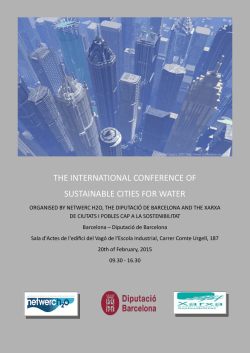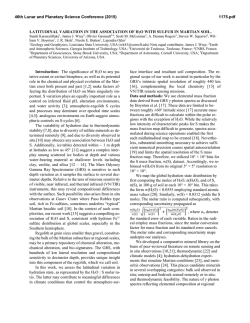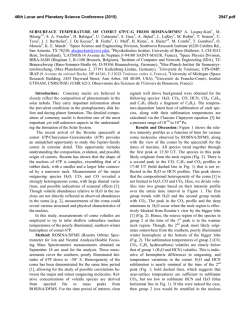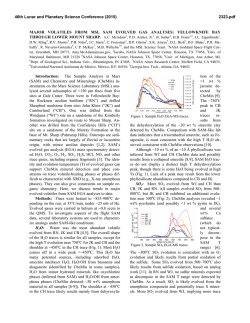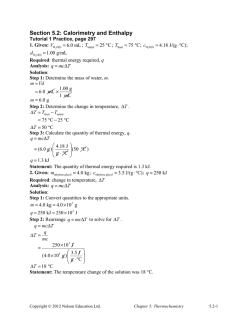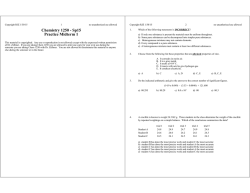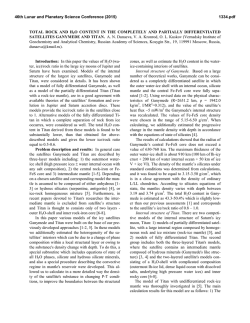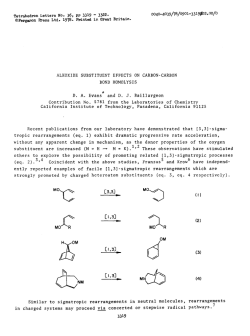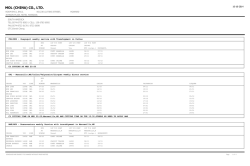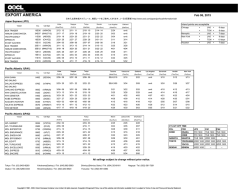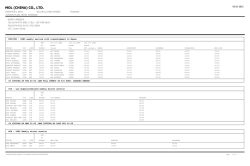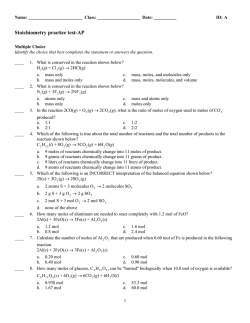
Chapter 5 - Thermochemistry
Chapter 5 - Thermochemistry Study of energy changes that accompany chemical rx’s. I) Nature of Energy Energy / Capacity to do work Mechanical Work w = Fxd Heat energy - energy used to cause the temperature of an object to inc. 1 A) Units of Energy w=Fxd = ( m x a) x d = (kg × m/s2) × m \ = (kg C m2)/ s2 = N × m = joule, J (SI unit) calorie (cal) original def: amt. of energy reg. to raise temp. of 1g of water by 1°C, from 14.5 °C to 15.5 °C 1 cal = 4.184 J Cal - nutritional calorie 1 kcal 2 B) Kinetic & Potential Energy 1) Kinetic Energy KE = ½ m v 2 Energy due to motion SI units: Energy = kg (m/s)2 = J 3 2) Potential Energy Energy stored in an object by virtue of its position or composition Chemical energy is due to composition of substances Electrostatic P.E. Interaction between charged particles Eel = 6 Q1 Q2 d Q = charge d = distance between particles 4 5 C) System and Surroundings System = portion we single out for study - focus attention on changes which occur w/in definite boundaries Surroundings = everything else System : Contents of rx. flask Surround. : Flask & everything outside it Agueous soln. rx : System : dissolved ions & molecules Surround : H2O that forms the soln. 6 II) First Law of Thermodynamics Law of Conservation of Energy : Energy can be neither created nor destroyed but may be converted from one form to another. Energy lost by system = Energy gained by surroundings A) Internal Energy, E E = total energy of the system Actual value of E cannot be determined 7 )E, change in energy, can be determined ) = final state ! initial state )E / Ef ! Ei Sign of )E is important Ef > Ei , )E > 0 system gained energy Ef < Ei , )E < 0 system lost energy Systems tend to go to lower energy state - more stable products i.e. rx’s in which )E < 0 8 B) Thermodynamic State & State Functions Thermodynamic State of a System defined by completely specifying ALL properites of the system - P, V, T, composition, physical st. 1) State Function prop. of a system determined by specifying its state. depends only on its present conditions & NOT how it got there )E = Efinal ! Einitial independent of path taken to carry out the change - Also is an extensive prop. 9 C) Relating )E to Heat & Work 2 types of energy exchanges occur between system & surroundings Heat & Work + q : heat absorbed, endothermic ! q : heat evolved, exothermic + w : work done on the system ! w : work done by the system 1) First Law )E = q + w 10 1) Exothermic Reactions heat is released 2 H2(g) + O2(g) 6 2 H2O(R) + heat 11 2) Endothermic Reactions heat is absorbed - reaction requires input of energy 2 H2O(R) + heat 6 2 H2(g) + O2(g) 12 III) Enthalpy In ordinary chem. rx., work generally arises as a result of pressure-volume changes Inc. vol. & system does work against pressure of the atmosphere P@V has dimensions of work : P@V = (F/A)V = (kg @ m/ s2 @ m2) m3 = (kg @ m2)/(s2) = J Constant Pressure w = ! P )V Negative because work done by system 13 )E = q ! P )V A) )E at Constant Volume )E = q v B) )E at Constant Pressure : )E = q p ! P )V qp = )E + P)V 14 C) Enthalpy, H H = E + PV Change in enthalpy at constant P is: )H = )E + P )V & )H = q p Can think of as heat content state fnc. & is extensive 15 IV) Enthalpies of Reaction )Hrxn = Hproducts ! Hreactants A) Exothermic Rx’s Hp < Hr , )Hrxn < O , exothermic Heat is evolved 2 H2(g) + O2(g) 6 2 H2O(R) )H = !572 kJ Thermochemical eqn. Physical states are given and energy associated w. rx. written to right - MUST give physical states If product is H2O(g), )H = !484kJ 16 )H corresponds to molar quantities given in eqn. as written H2(g) + ½ O2(g) 6 H2O(R) )H = !286 kJ B) Endothermic Rx’s Hp > Hr , )Hrxn > O , endothermic Heat is absorbed 2 H2O(R) 6 2 H2(g) + O2(g) )H = +572kJ Reverse of previous rx. 17 Enthalpy Diagram 2 H2 (g) + O2 (g) !572 kJ +572 kJ 2 H2O (R) 18 C) Guidelines 1) Enthalpy is extensive Multiply a rxn by some factor the )H is multiplied by that factor 2) )Hreverse = ! )Hforward 3) Enthalpy is a state function )H depends on the states of reactants and products. 19 D) Determining )H for a Rx. Convenient sample sizes are reacted & conv. factors are used to obtain the heat energy 1) Ex 1: When 36.0g of Al reacts w. excess Fe2O3 how much heat is released? 2 Al(s) + Fe2O3(s) 2 Fe(s) + Al2O3(s) )Hrxn = !847 kJ 1 mol Al 847 kJ ? kJ = 36.0 g Al x -------------- x ------------ = 565.08 kJ = 565 kJ 26.98 g Al 2 mol Al 20 VII) Calorimetry Exp. method of obtaining )H & )E Heat evolved or absorbed by system will be reflected in the surroundings. Need surr. Heat Capacity, C q C = )T Quantity of heat required to raise the temp. of an object by 1 °C Unit: (J/°C) or (J/K) 21 Cm - molar heat capacity heat capacity per mole, J/molC°C Cs - specific heat heat capacity per gram, J/gC°C Cs of H2O = 4.184 J/gC°C q = C × )T q = n × Cm × )T q = m × Cs × )T qgained = ! qlost Calorimeter )H (qp) Bomb Calorimeter )E (qv) 22 23 A) Ex 1: What amt. of heat has been absorbed by 1.000 kg of water if its temp. inc. from 18.22 °C to 22.73 °C? q = m × Cs × )T = (1.000 × 103g) (4.184 J/gC°C)(22.73!18.22) 9 4.51 °C = 18,869.84 J = 18.9 kJ (3 s.f.) 24 B) Ex 2: A 0.562 g sample of graphite is placed in a bomb calorimeter & ignited in the presence of excess O2 at 25.00 °C & 1 atm. The temp. of the calorimeter rises to 25.89 °C. The heat capacity of the calorimeter & contents is 20.7 kJ/°C. What is )H at 25.00 °C and 1 atm? C(graphite) + O2(g) 6 CO2(g) q(lost by rxn) = ! q(gained by calor. & contents) qrxn = ! Ccal )T = ! (20.7 kJ/°C)(25.89 °C - 25.00 °C) = ! 18.4 kJ (qv or )E for 0.562 g) 25 Want kJ/mol, kJ ! 18.4 kJ 12.0 g C ? ------- = -------------- x -----------mol 0.562 g C 1 mol C = ! 3.93 x 102 kJ )E = ! 3.9 x 102 kJ/mol since no change in moles of gas )H = )E 26 VI) Hess’s Law )H is a state fnc. Same whether the process occurs as a single step or as a series of steps The )Hrxn is the sum of the )H’s for the individual steps. )Hrx = G )Hsteps Steps * Add chem. eqn’s for steps to get overall rxn. * Add )Hsteps | )Hrxn 27 A) Ex 1 : What is )H for Ca(OH)2(s) + SO3(g) 6 CaSO4(s) + H2O(g) We know the following: Ca(OH)2(s) 6 CaO (s) + H2O(g) )H1 = + 109 kJ CaO(s) + SO3(g) 6 CaSO4(s) )H2 = ! 401 kJ Ca(OH)2(s) + CaO(s) + SO3(g) 6 )Hrxn = !292kJ CaSO4(s) + CaO(s) + H2O(g) )Hrxn = )H1 + )H2 28 B) Ex 2 :Want )H for rxn. C2H2(g) + 5N2O(g) 6 2CO2(g) + H2O(g) + 5N2(g) Have: 2 C2H2(g) + 5 O2(g) 6 4 CO2(g) + 2 H2O(g) )H1a = !2512 kJ N2(g) + ½ O2(g) 6 N2O(g) )H2a = + 81.6 kJ Adjust eqn’s so they are in proper amt’s and the correct directions so they add up to the desired eqn. ALL substances NOT appearing in desired eqn. MUST cancel. 29 Divide eqn. 1a by 2 (also )H ) C2H2(g) + 5/2 O2(g) 6 2 CO2(g) + H2O(g) )H1b = ! 1256 kJ Reverse eqn. 2a and multiply by 5 5 N2O(g) 6 5 N2(g) + 5/2 O2(g) )H2b = ! 408 kJ Add & Cancel C2H2(g) + 5N2O(g) 6 2CO2(g) + H2O(g) + 5N2(g) )Hrxn = )H1b + )H2b = ! 1256 kJ + ! 408 kJ = ! 1664 kJ 30 C) Note: In using Hess’s Law: 1) If an eqn. is multiplied by a factor, )H is multiplied by the same factor. 2) If an eqn. is reversed, sign of )H changes 3) All substances NOT appearing in desired eqn. MUST cancel 31 VII) Enthalpy of Formation Enthalpy change for the formation of a compound from its elements )Hf A) Standard enthalpy change Enthalpy change when all reactants and and products are in their standard states )H° 32 1) Standard State Most stable state of a substance in its pure form under standard pressure (1 atm) & some specified temp. of interest (usually 25 °C) 2) Thermochemical Standard States A) solid or liquid Pure substance at 1 atm b) gas pressure of 1 atm c) species in solution Conc. of 1 M 33 B) Standard Enthalpy of Formation )H for the rxn in which 1 mole of a cmpd. is formed from its elements with ALL substances in their standard states (in kJ/mol) )Hf° Note: )Hf° = 0 for an element in its standard state )Hf° 1/2 N2(g) + 3/2 H2(g) 6 NH3(g) ! 46.2 Na(s) + 1/2 Cl2(g) 6 NaCl(s) ! 411.0 C(graphite) 6 C(diamond) + 1.897 34 35 C) Determine )Hrxn ° from )Hf° )Hrxn ° = 3 n )Hf° ! 3 m )Hf° prod. react. n = coef. in bal. eqn. for each product m = coef. in bal. eqn. for each reactant 36 1) Ex1 : Find )Hrxn ° for the following rx. using Hess’s Law and )Hf°. 2 H2S(g) + 3 O2(g) 6 2 H2O(R) + 2 SO2(g) )H° (kJ/mol) (a) H2(g) + S(s) 6 H2S(g) ! 20.2 (b) H2(g) + ½ O2(g) 6 H2O(R) ! 285.8 (c) S(s) + O2(g) 6 SO2 (g) ! 296.9 Need to: Rev. eqn. (a) and × 2 Add eqn. (b) × 2 Add eqn. (c) × 2 37 2H2S(g) 6 2H2(g) + 2S(s) )Hrxn = !2C(!20.2) = + 40.4 kJ 2H2(g) + O2(g) 6 2H2O (R) )Hrxn= 2(!285.8) = ! 571.6 kJ 2S(s) + 2O2(g) 6 2SO2(g) )Hrxn = 2(!296.9) = ! 593.8 kJ 2H2S + 2H2 + 2S +3O2 6 2H2 + 2S + 2H2O + 2SO2 2H2S + 3O2 6 2H2O + 2SO2 )Hrx = (+ 40.4) + (!571.6) + (!593.8) = ! 1125 kJ 38 a) Use )Hf° instead )Hrxn ° = [ 2 )Hf° (H2O) + 2 )Hf° (SO2)] ! [ 2 )Hf° (H2S) + 3 )Hf° (O2)] = [2 (!285.8) + 2 (!296.8)] ! [2 (!20) + 3 (0)] = ! 1125 kJ 39 2) Ex 2: Useful when considering organic cmpds. for which )Hf° can not be determined directly. What is )Hf° for benzene? 6 C(s) + 3 H2(g) 6 C6H6(R) )Hf° = ? This rx. does not happen. Use of exp. heat of combustion C6H6(R) + 15/2 O2(g) 6 6 CO2(g) + 3 H2O(R) )Hrxn ° = ! 3271 kJ 40 )Hrxn ° = [ 6 )Hf° (CO2) + 3 )Hf° (H2O)] ! [ )Hf° (C6H6) + 15/2 )Hf° (O2)] !3271 kJ = [ 6 (!393.5) + 3 (!285.8) ] ! [ )Hf° (C6H6) + 15/2 (0) ] !3271 kJ = [! 3218.4] ! [ )Hf° (C6H6) ] )Hf° (C6H6) = [! 3218.4] ! (! 3271) = + 52.6 kJ 41
© Copyright 2025
